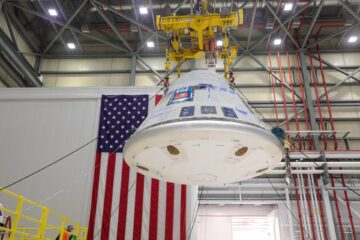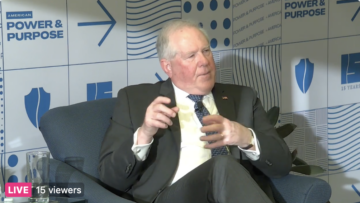WASHINGTON — The U.S. Space Force is kicking off a major procurement of next-generation communications satellites critical to the nation’s nuclear command, control and communications network.
This estimated $8 billion procurement, known as Evolved Strategic Satcom (ESS), will supplement and eventually replace the existing Advanced Extremely High Frequency (AEHF) satellite constellation. The new system will provide critical jam-resistant communication channels for the National Command Authorities and deployed forces worldwide, even in the North Polar region – a capability lacking in the current system.
The Space Systems Command on April 5 issued a pre-solicitation alerting that a final request for proposals will soon be released for the ESS satellites. The ground systems and user terminals are being acquired under separate procurements.
The Space Force is aiming to start production in 2025 and field a new constellation by 2030. The ESS constellation would have at least four interconnected satellites in geosynchronous and highly elliptical orbits.
Boeing-Northrop face off
Boeing and Northrop Grumman are the top contenders for this contract as both companies have been developing prototypes for ESS since 2020 under government contracts. But the Space Systems Command said the production phase will be an open competition, a fair game for any qualified competitor.
Northrop Grumman said the company “successfully completed a capstone technology demonstration in December” for its ESS prototype. “Northrop Grumman is in the final stages of incorporating lessons learned from the rapid prototype into our ESS production proposal, which we will deliver this year,” a spokesperson said April 25 in a statement.
Boeing also is working on an ESS prototype using satellite bus and payload technologies developed for other military and commercial programs.
The chosen contractor will receive a cost-plus, or cost-reimbursement contract. This approach, as opposed to a fixed-price contract, acknowledges design uncertainties remain in the program and commits the government to pay contractors for permitted expenses plus an agreed profit margin.
- SEO Powered Content & PR Distribution. Get Amplified Today.
- PlatoData.Network Vertical Generative Ai. Empower Yourself. Access Here.
- PlatoAiStream. Web3 Intelligence. Knowledge Amplified. Access Here.
- PlatoESG. Carbon, CleanTech, Energy, Environment, Solar, Waste Management. Access Here.
- PlatoHealth. Biotech and Clinical Trials Intelligence. Access Here.
- Source: https://spacenews.com/space-force-opens-bidding-for-classified-communications-satellites/
- :is
- 1
- 10
- 12
- 13
- 17
- 19
- 2020
- 2025
- 2030
- 24
- 25
- 300
- 41
- 46
- 5
- 50
- 6
- a
- acquired
- advanced
- again
- agreed
- Aiming
- Alert
- also
- an
- and
- any
- approach
- April
- ARE
- AS
- At
- Authorities
- BE
- been
- being
- Billion
- both
- bus
- but
- button
- by
- capability
- channels
- chosen
- classified
- Close
- command
- commercial
- commits
- Communication
- Communications
- Companies
- company
- competition
- competitor
- Completed
- contenders
- contract
- Contractor
- contractors
- contracts
- control
- couldn
- critical
- Current
- day
- Defense
- deliver
- demonstration
- deployed
- Design
- developed
- developing
- error
- estimated
- Ether (ETH)
- Even
- eventually
- evolved
- existing
- expenses
- extremely
- Face
- fair
- fair game
- false
- field
- final
- final stages
- For
- Force
- Forces
- four
- Frequency
- from
- game
- get
- Government
- Ground
- Have
- Hidden
- High
- highly
- HTTPS
- in
- incorporating
- interconnected
- into
- Issued
- ITS
- journalist
- known
- lacking
- latest
- learned
- least
- Lessons
- Lessons Learned
- List
- major
- Margin
- max-width
- Military
- National
- Nations
- network
- New
- Newsletter
- next-generation
- North
- nuclear
- of
- off
- on
- open
- opens
- opposed
- or
- Other
- our
- page
- Pay
- phase
- plato
- Plato Data Intelligence
- PlatoData
- please
- plus
- polar
- pop-up
- process
- procurement
- Production
- Profit
- Program
- Programs
- proposal
- Proposals
- prototype
- prototypes
- provide
- publish
- qualified
- rapid
- RE
- receive
- region
- released
- remain
- replace
- request
- s
- Said
- satellite
- satellite constellation
- satellites
- separate
- since
- Soon
- Space
- Space Force
- spokesperson
- stages
- start
- Statement
- Status
- Strategic
- subscription
- supplement
- system
- Systems
- T
- Technologies
- Technology
- terminals
- that
- The
- There.
- this
- this year
- to
- top
- true
- try
- Tuesday
- u.s.
- U.S. Space Force
- uncertainties
- under
- User
- using
- veteran
- was
- we
- which
- will
- worldwide
- would
- year
- you
- Your
- zephyrnet






